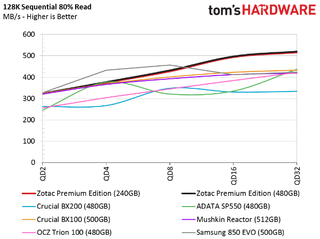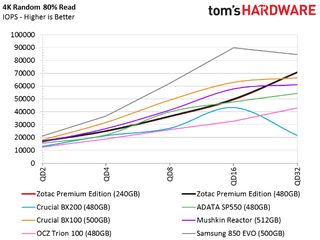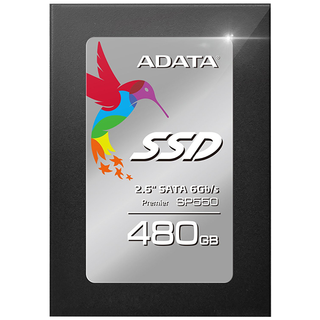Zotac Premium Edition SSD Review
Armed with Phison's new v.1.6 firmware for the S10 processor and low-cost flash, Zotac takes aim at the mainstream and gamer SSD markets.
Why you can trust Tom's Hardware
Performance Test Results
Data Type Performance Comparison



Phison's S10 controller handles compressible and incompressible data differently. Compressible small-block reads come from the S10 a bit faster than an equivalent test using incompressible data. We don't mind the boost with compressible data when the lowest performance is so high to start with, though. Don't make the mistake of thinking this is similar to SandForce-based SSDs, where incompressible data affects the speed at which small and large block sizes are written to the drive.
The new 1.6 firmware juggles incompressible data a little more adeptly than previous builds we've tested. Most of our tests use this type of data, so you will see the Premium Edition SSD move up the performance charts in most of our metrics compared to products we tested previously based on the same controller.
Sequential Read
To read about our storage tests in-depth, please check out How We Test HDDs And SSDs. Four-corner testing is covered on page six of our How We Test guide.


One thing that hasn't changed is the S10 controller's ability to read sequential data very quickly. We've yet to test an S10-based drive paired with MLC flash that didn't dominate this benchmark. Even at low queue depths, the quad-core controller extracts a lot of performance from the flash.
Sequential Write
When we previously measured the sequential write speed of S10-based drives, they always showed up around the top of the charts. Phison's newest firmware pegs Zotac's Premium Edition SSD at the top, though. Gamers looking for shorter level load times will benefit from these high sequential read and write numbers.
Both the 240GB and 480GB Premium Edition drives deliver nearly identical performance through both sequential tests. These are the first low-cost SSDs that keep pace with Samsung's 850 EVO. Even more impressive, the 240GB model manages to outperform many of the higher-capacity drives we're comparing it to.
Random Read



Historically, Phison controllers ran into issues working with small blocks of data. And randomly-accessed information is almost exclusively in small blocks (at least in Windows). When we test SSDs and separate them into performance classes, we use random read performance at a queue depth of one as our scale. Any drive that scores less than 7000 IOPS falls in the lower end of the scale, where you find budget-oriented products. The middle tier ranges from 7000 to 9000 IOPS. Any SSD capable of delivering more than 10,000 IOPS is special indeed. Very few SATA-attached SSDs can do this. Even PCIe-based SSDs often have trouble crossing that threshold.
Zotac's Premium Edition SSD makes it into our exclusive club, though. This is the level of performance we've always expected from the quad-core S10 paired with MLC flash. After a year of work under its hood, the controller now lives up to our expectations. What surprises us is that the S10 delivers so much performance over AHCI, rather than an NVMe interface.
Random Write



The Premium Edition SSD's random write performance is also very high. Again, we see the Zotac SSDs on equal ground as Samsung's 850 EVO. It's easier to realize higher queue depths during random write operations than random reads. Because of that, we look further up the queue depth range, where we find the Premium Edition SSDs comparable with the 850 EVO 500GB once more.
80 Percent Sequential Mixed Workload
Our mixed workload testing is described in detail here, and our steady state tests are described here.

The SATA bus is half-duplex, so it can read data or write it, but it can't do both at the same time. With one read and one write in the queue (represented by QD2 in our chart), Zotac's two Premium Edition SSDs operate at the same rate as the Samsung 850 EVO. As you stack more commands, the 850 EVO 500GB performs a little better until a queue depth of 16, where the Premium Edition drives gain an advantage moving 128KB blocks sequentially.
80 Percent Random Mixed Workload

Even though Phison continues improving small-block random performance, the mixed workload test shows that more work is needed to completely overtake the 850 EVO 500GB.
Sequential Steady State



The sequential steady state test shows that Phison has the S10 firing on all cylinders. The company always planned to take this controller to the enterprise market in some form, and firmware is key to making that happen. As the firmware matures to address those higher-end requirements, client SSDs with the same controller hardware will benefit along the way.
High sequential steady state performance is ideal for a few different applications. Most of us will never get into steady state unless the drive fills up. Audio and video production can get down into this state, too, but only after hours of heavy writes to the drive.
Random Write Steady State


Random small-block steady state only really happens in the enterprise, and almost exclusively on database servers. We use this test to look for performance consistency. When SSDs achieve high and consistent performance, they are better at operating in RAID arrays.
The Zotac Premium Edition SSDs deliver a bit more than 2500 random write IOPS on average, though they demonstrate several peaks. As it sits right now, this budget SSD doesn't have what we like to see for RAID configurations. The upcoming 2.0 firmware is supposed to address the low steady state write IOPS performance and deliver higher consistency.
Current page: Performance Test Results
Prev Page A Closer Look Next Page Real-World Software PerformanceStay on the Cutting Edge
Join the experts who read Tom's Hardware for the inside track on enthusiast PC tech news — and have for over 25 years. We'll send breaking news and in-depth reviews of CPUs, GPUs, AI, maker hardware and more straight to your inbox.
-
Onus If I needed another SSD, I'd definitely put this one on my short list. I have a question though, that pertains more to testing in general than to this specific drive, but it certainly applies: will two identical SSDs (including same firmware, e.g. two units bought off the shelf at the same time) have identical performance? We know that the "silicon lottery" affects timing and overclocking limits on RAM; does it also play a role in SSD performance? I would think not, but if so, would love to know why, and how much. Thanks.Reply
-
icepick314 I don't know...Reply
Samsung Evo Pro 1TB with 10 year warranty is around $400-$450...
I say splurge a little and get the capacity, performance, and 10 years of worry-free storage... -
salgado18 ReplyI don't know...
I say if you want a drive for 10 years, wait for the new tech to arrive this year, a lot faster (over 3x) and with new connections (SATA is old already).
Samsung Evo Pro 1TB with 10 year warranty is around $400-$450...
I say splurge a little and get the capacity, performance, and 10 years of worry-free storage... -
LordConrad Just out of curiosity, how do these drives compare to the Samsung 850 Pro on notebook battery life?Reply -
Onus Yes, please add power consumption. The Samsung drives are remarkable in how little idle power they use compared to competitors (I believe it is typically 30%).Reply -
g-unit1111 Reply17403001 said:Just out of curiosity, how do these drives compare to the Samsung 850 Pro on notebook battery life?
Yes. I would be curious about this as well. This looks like a fairly nice drive and $140 for 480GB and Toshiba NAND looks pretty solid and a decent competitor to Samsung. -
shrapnel_indie Well, I wonder how TH would rank Toshiba's Q300 offerings against this and Samsung... from what I seen elsewhere their Q300 series puts up quite a fight with Samsung.Reply -
CRamseyer Thanks for all of the excellent questions.Reply
We tested the Q300 Pro (MLC version) and the review is in queue. We do not have the Q300 drive with TLC.
On the notebook battery life front, we measured the 850 Pro 512GB at 657 minutes. There are so many good drives available now and such a wide divide between the high performance and low cost models that we charts the drives separate.
There are size limits to for the performance charts. At some point I plan to list a couple of hundred drives in massive charts so everyone can see how they all stack up.
The 850 Pro is the only model from Samsung with a 10 year warranty. The 850 EVO carries a 5-year warranty. The SanDisk Extreme PRO also carries 10 years of coverage.


